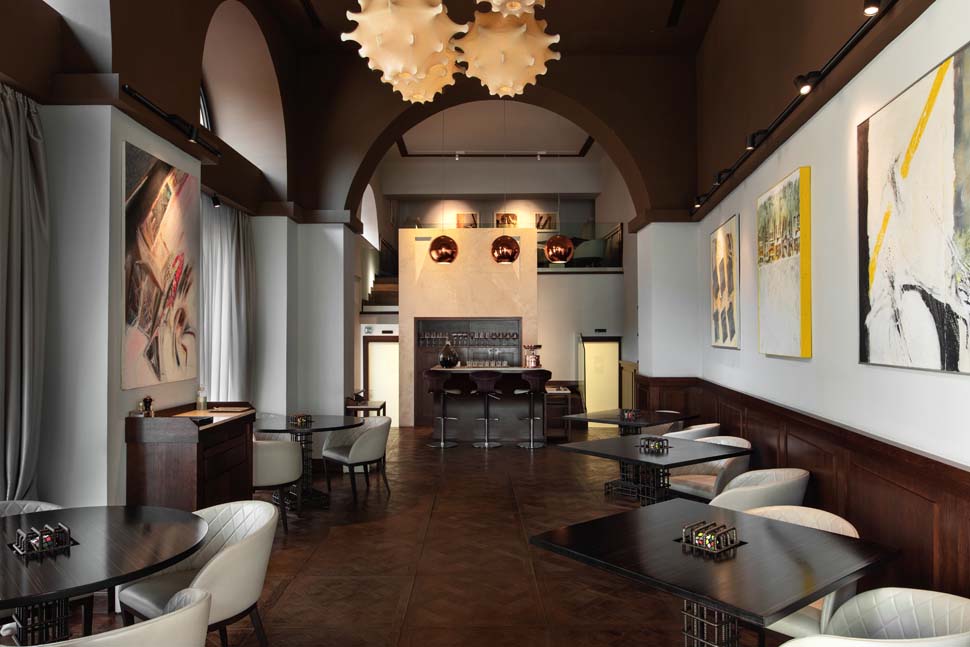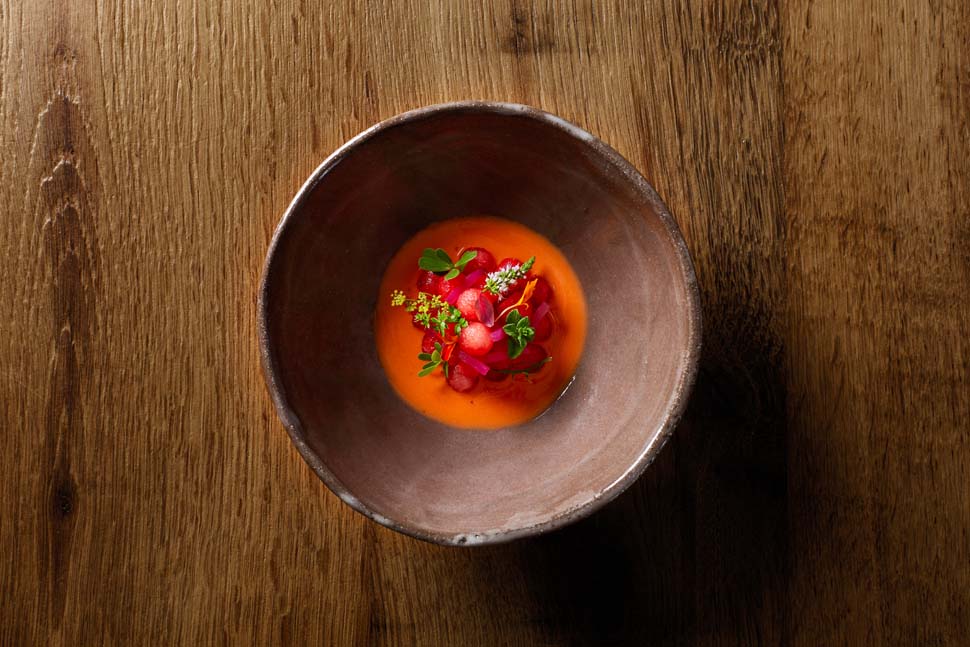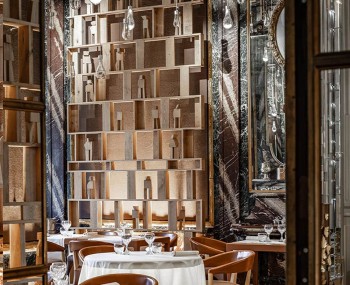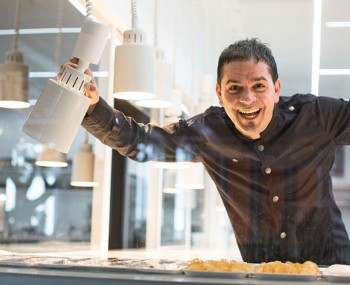Creative, precise, effervescent: Ciro Scamardella's cuisine interweaves the teachings of Roy Caceres, a master of fusion himself, with the appeal of Neapolitan origins and a centralizing Made in Italy focus on the primary ingredients. Finding the perfect counterpoint to the playful plates is the professionalism of a great dining room.
Pipero
The restaurant
The latest MICHELIN Guide bet on Rome, leaving Milan somewhat in the lurch. And it was a winning bet since the Roman restaurant scene is one that has a lot going on. It is composite and original, taking on its own distinct shape. Among the protagonists of this scene, there is Alessandro Pipero, who left the historic Rex location and, in 2018, reopened on central Corso Vittorio Emanuele, inside completely remodeled spaces. 
With him was Chef Luciano Monosilio, who has since chosen other paths. A gamble? Probably so, when so many seek the haven of a large establishment. Moreover, businesses centered on the figure of the owner can be counted on one hand in Italy. Still, the challenge has been met, thanks in part to the right partner.
When he entered the kitchen in 2019, Ciro Scamardella was 30 years old and did not have experience as a chef. From Bacoli in Campania, he endured grueling apprenticeships, mostly in the capital. "I had little desire to go to school as a kid, but the first extras during hotel school made me realize there was fun to be had. Then a couple of seasons in Filicudi and Elba Island, the move to Gambero as a tutor in professional courses and the meeting with Paolo Barrale, at whose side I stayed for a year and a half; and then Villa Crespi, Il Pagliaccio, Metamorfosi and Martin Berasategui's Lasarte.” 
“I had a job offer ready to go when Genovese came around again for the role of head chef, then after a year working starters, it was Caceres who let me know he was missing a junior sous-chef. I spent four years with him and came out second. I owe him so much: he has great technique and he’s very smart, he doesn't take anything for granted, and he always asks why things happen. But all the chefs I met helped me reflect."
"When I arrived, I suffered a bit from the owner's prominent status, then little by little, we aligned, and it all came naturally. We are a happy couple who have overcome a marital crisis," he jokes. And irony is precisely the glue between the two: as professional as they are easygoing, virtuosos of severe ludit (a Latin term that means ‘he plays hard’ but is used to describe the playfyul, Roman sardonic culture) that has been at home in the Eternal City for a few millennia. Certainly, Scamardella's cuisine has little to do with Monosilio's more rustic feel beneath the avant-garde patina. Here the fabric is fine, the texture exact, and the concentration chess-like. Scamardella has more style than a technical background: "I love Italian, French, South American, and Asian cuisine. I read a lot and travel to experiment. I would like to create a tunnel between historic Neapolitan gastronomy and Japan."
And in fact, there is always a novelty simmering in the pot. Perhaps behind some tip from Alessandro, who is a wandering foodie; take, for example, the polpettine takoyaki alle acciughe (dry-aged, whole anchovy takoyaki) or il guacamole di cime di rapa ingrassate nell’olio (confit turnip guacamole), which will have to wait for the next winter season, though... "We catalogue everything, we have an internal log of the things we make, and maybe they go through a rotation. The creative process has a logic that we schematize and organize. I feel I am the interpreter of a free cuisine, with no constraints to repertoire or regional ingredients. What counts is fun and respect for the ingredient, a narrative of the recipe that, however, should never be imposed at the table." The result is a thoughtful, fun, fluid and light cuisine that is eclectic in inspiration and prone to variety. 
Since last September, there is the possibility of booking online with a choice of a tasting menu. "This way, everyone is able to give their best. The work is smoother, the margin of error is lower, the service follows a good cadence, and the experience at the table is standardized. It is easier to focus on new dishes and adjust investments based on data."
In practice, there are three surprise tasting menus of 3, 6 or 8 courses (at 100, 140 and 160 euros, respectively, plus 70 for drink pairings), flanked by a list of "musts" for the more hesitant to leave it to fate. It includes Scamardella's signature dishes but also carbonara using Pipero's untouched recipe and crêpes made at the table by maître Achille Sardiello, accompanied by a 500-bottle wine list, compiled by Pipero and served by Sardiello, a list that boasts Burgundies and Champagnes.
The dishes
Appetizers focus on acidity: radishes in carpione (preserved in vinegar) with hazelnut and fennel cream, squid meatball with grapefruit chutney, and curry and smoked eel spherical. Or, for a cozier palate: bruschetta with lemon butter and “Quel porco di Pipero,” a mushroom waffle with Ciauscolo (an IGP cured sausage from the mountains of Umbria). "It surprises the palate with different peaks and textures, alternating gluttony and exploration." Then the fun starts right away, with a tribute to Caceres: the "ceviche" without fish, composed of winter melon with leche de tigre, lemon zest, scented with Cuban oregano. "A single herb note, rather than a bouquet." Focaccia from Baria and freshly sliced bread round it out.

The Naples-Tokyo intercontinental exchange begins with Chawanmushi, a Japanese steamed savory egg custard with beef broth and garnished with 'o pere e 'o musso, Neapolitan street food of tendons, pepper, and lemon, plus green onion and marjoram. A fresh dish with intriguing textures. Then chicken and potatoes enter the game as a play on pulled pork. A dish recalling a coast-to-coast trip across the US. Using the same technique of marinating and barbecuing, but applied to chicken, which is carefully pulled apart and inserted as stuffing into a waxy potato, then brushed with barbecued oil and flame-grilled with the sauce. The outcome is a parmentier to “the nth degree,” a Sunday feast that takes you places.


But Scamardella is also something else. For example, as a good Neapolitan, the 'mpepata (peppered mussels), a masterpiece of Italian minimalism whose ingredients he does not touch but elevates through complex elaborations for an already tastefully perfect bite. The mussels are topped with their own mousse, lemon zest, and juice – which naturally thickens the texture – with pepper, placed in a veil of mussel water. "In Bacoli, the Romans called mussels 'black oysters.' It is a dish that marked a new direction, the one that best represents me today."


More Italian minimalism in the bottoni di Ciauscolo (ravioli filled with IGP Ciauscolo sausage), where there is almost a sole note of umami flavor: beef broth with a little ponzu sauce to refresh and prolong the pasta is made with only egg yolks to be like a callous over the liquid heart, inside the Ciauscolo releases its animal spirits, barely tempered by the calibrated balance of a béchamel to round it out. "And it was not easy to find the right balance so that the sausage retained its character without being overpowering with notes bordering on rancid. Having a carbonara on the menu allows us to have fun with the first courses." So, there is fregula (a pasta shape typical of Sardinia) as creamy as risotto thanks to the seafood, clam water, and coconut milk butter, without fat, plus parsley chlorophyll and sea lettuce powder. A dish between Sardinia and Thailand, on an imaginary tropic.

The meat dish subverts the proportions between pièce (main piece of a dish) and garniture (garnish): it is an osmosis of spiced griddled radicchio in carpione, served with a red fruit wine sauce and diced sweetbreads à l'ancienne. "Because I love classic cooking, cooking meats and fish on the bone, whipping sauces, tasseling." Balancing bitter and sweet, sour, and fatty, the bite of a vegetable version of meat.

The pre dessert makes light of a chamomile tea, served at the end of the meal. A composition of a honey disc, lemon gel, chamomile sorbet, lavender mousse and “piperelli” – candied blossoms. Followed by the ultimate nostalgia: 081, a dessert that phones home with the area code reproduced in pastry shells sprayed at the table with orange blossom water for a domestic oven sensation, the coffee "corretto" (an espresso with a shot of grappa) mousse with aniseed ice cream, Varnelli gel, and Maxibon (a typical Italian ice cream sandwich). Lastly, hazelnut cream choux confectionary, hazelnut cookies, a spoon of creamy pistachio butter, and candied hazelnuts rolled in bitter cocoa.

Address
Pipero Roma
Corso Vittorio Emanuele, 246/248/250 – 00186 Roma
Tel. +39 06 68139022











